Related Research Articles

In geology and mineralogy, a mineral or mineral species is, broadly speaking, a solid substance with a fairly well-defined chemical composition and a specific crystal structure that occurs naturally in pure form.
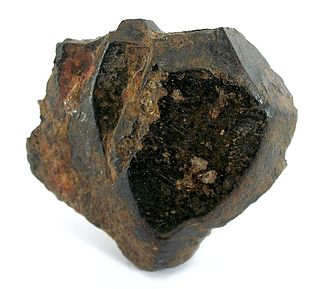
Ilmenite is a titanium-iron oxide mineral with the idealized formula FeTiO
3. It is a weakly magnetic black or steel-gray solid. Ilmenite is the most important ore of titanium and the main source of titanium dioxide, which is used in paints, printing inks, fabrics, plastics, paper, sunscreen, food and cosmetics.
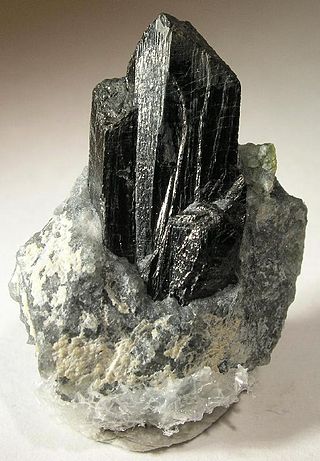
Baddeleyite is a rare zirconium oxide mineral (ZrO2 or zirconia), occurring in a variety of monoclinic prismatic crystal forms. It is transparent to translucent, has high indices of refraction, and ranges from colorless to yellow, green, and dark brown. See etymology below.

Brookite is the orthorhombic variant of titanium dioxide (TiO2), which occurs in four known natural polymorphic forms (minerals with the same composition but different structure). The other three of these forms are akaogiite (monoclinic), anatase (tetragonal) and rutile (tetragonal). Brookite is rare compared to anatase and rutile and, like these forms, it exhibits photocatalytic activity. Brookite also has a larger cell volume than either anatase or rutile, with 8 TiO2 groups per unit cell, compared with 4 for anatase and 2 for rutile. Iron (Fe), tantalum (Ta) and niobium (Nb) are common impurities in brookite.

Ankerite is a calcium, iron, magnesium, manganese carbonate mineral of the group of rhombohedral carbonates with the chemical formula Ca(Fe,Mg,Mn)(CO3)2. In composition it is closely related to dolomite, but differs from this in having magnesium replaced by varying amounts of iron(II) and manganese. It forms a series with dolomite and kutnohorite.

Bournonite is a sulfosalt mineral species, trithioantimoniate of lead and copper with the formula PbCuSbS3.
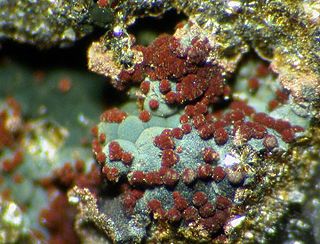
Robertsite, Ca3(Mn3+)4[(OH)3| (PO4)2]2·3(H2O) (alternatively formulated Ca2(Mn3(PO4)3O2)(H2O)3), is a secondary phosphate mineral named for Willard Lincoln Roberts (1923–1987), mineralogist and professor at South Dakota School of Mines in Rapid City, South Dakota.
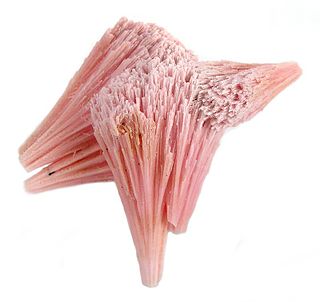
Kutnohorite is a rare calcium manganese carbonate mineral with magnesium and iron that is a member of the dolomite group. It forms a series with dolomite, and with ankerite. The end member formula is CaMn2+(CO3)2, but Mg2+ and Fe2+ commonly substitute for Mn2+, with the manganese content varying from 38% to 84%, so the formula Ca(Mn2+,Mg,Fe2+)(CO3)2 better represents the species. It was named by Professor Bukowsky in 1901 after the type locality of Kutná Hora, Bohemia, in the Czech Republic. It was originally spelt "kutnahorite" but "kutnohorite" is the current IMA-approved spelling.
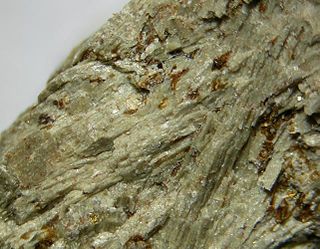
Aliettite is a complex phyllosilicate mineral of the smectite group with a formula of (Ca0.2Mg6(Si,Al)8O20(OH)4·4H2O) or [Mg3Si4O10(OH)2](Ca0.5,Na)0.33(Al,Mg,Fe2+)2−3(Si,Al)4O10(OH)2·n(H2O).
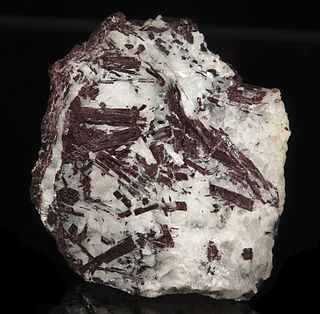
Piemontite is a sorosilicate mineral in the monoclinic crystal system with the chemical formula Ca2(Al,Mn3+,Fe3+)3(SiO4)(Si2O7)O(OH). It is a member of the epidote group.
Cleusonite is a member of the crichtonite group of minerals with the chemical formula (Pb,Sr)(U4+
,U6+
)(Fe2+
,Zn)
2(Ti,Fe2+
,Fe3+
)
18(O,OH)
38. This group of minerals contains approximately thirteen complex metal titanates. The structures of minerals of this group is complicated by frequent fine-scale twinning and metamictization due to radioactive elements. The crichtonite group consists of members of related mineral species of the type A{BC2D6E12}O38 which are characterized by their predominant cations (as seen in crichtonite (Sr), senaite (Pb), davidite (REE + U), landauite (Na), loveringite (Ca), lindsleyite (Ba), and mathiasite (K).
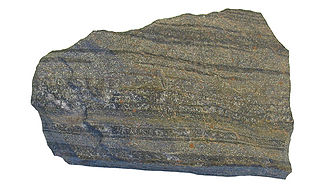
Iron-rich sedimentary rocks are sedimentary rocks which contain 15 wt.% or more iron. However, most sedimentary rocks contain iron in varying degrees. The majority of these rocks were deposited during specific geologic time periods: The Precambrian, the early Paleozoic, and the middle to late Mesozoic. Overall, they make up a very small portion of the total sedimentary record.
This list gives an overview of the classification of non-silicate minerals and includes mostly International Mineralogical Association (IMA) recognized minerals and its groupings. This list complements the List of minerals recognized by the International Mineralogical Association series of articles and List of minerals. Rocks, ores, mineral mixtures, not IMA approved minerals, not named minerals are mostly excluded. Mostly major groups only, or groupings used by New Dana Classification and Mindat.

Geikielite is a magnesium titanium oxide mineral with formula: MgTiO3. It is a member of the ilmenite group. It crystallizes in the trigonal system forming typically opaque, black to reddish black crystals.
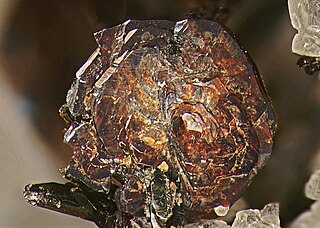
Pyrophanite is a manganese titanium oxide mineral with formula: MnTiO3. It is a member of the ilmenite group. It is a deep red to greenish black mineral which crystallizes in the trigonal system.

Tumchaite, Na2(Zr,Sn)Si4O11·H2O, is a colorless to white monoclinic phyllosilicate mineral. It is associated with calcite, dolomite, and pyrite in the late dolomite-calcite carbonatites. It can be transparent to translucent; has a vitreous luster; and has perfect cleavage on {100}. Its hardness is 4.5, between fluorite and apatite. Tumchaite is isotypic with penkvilksite. The structure of the mineral is identified by silicate sheets parallel {100}, formed by alternation of clockwise and counterclockwise growing spiral chains of corner-sharing SiO4 tetrahedra. Tumchaite is named for the river Tumcha near Vuoriyarvi massif.
In geology and mineralogy, a mineral group is a set of mineral species with essentially the same crystal structure and composed of chemically similar elements.

The Siilinjärvi carbonatite complex is located in central Finland close to the city of Kuopio. It is named after the nearby town of Siilinjärvi, located approximately 5 km west of the southern extension of the complex. Siilinjärvi is the second largest carbonatite complex in Finland after the Sokli formation, and one of the oldest carbonatites on Earth at 2610±4 Ma. The carbonatite complex consists of a roughly 16 km long steeply dipping lenticular body surrounded by granite gneiss. The maximum width of the body is 1.5 km and the surface area is 14.7 km2. The complex was discovered in 1950 by the Geological Survey of Finland with help of local mineral collectors. The exploration drilling began in 1958 by Lohjan Kalkkitehdas Oy. Typpi Oy continued drilling between years 1964 and 1967, and Apatiitti Oy drilled from 1967 to 1968. After the drillings, the laboratory and pilot plant work were made. The mine was opened by Kemira Oyj in 1979 as an open pit. The operation was sold to Yara in 2007.
Ophirite is a tungstate mineral first discovered in the Ophir Hill Consolidated mine at Ophir district, Oquirrh Mountains, Tooele County, Utah, United States of America. It was found underground near a calcite cave in one veinlet, six centimeters wide by one meter long, surrounded by different sulfides. Before the closing of the mine in 1972, it was dominated by sulfide minerals, and the Ophir district was known for being a source of zinc, copper, silver, and lead ores. The crystals are formed as tablets. It is the first known mineral to contain a heteropolyanion, a lacunary defect derivative of the Keggin anion. The chemical formula of ophirite is Ca2Mg4[Zn2Mn3+2(H2O)2(Fe3+W9O34)2] · 46•H2O. The mineral has been approved by the Commission on New Minerals and Mineral Names, IMA, to be named ophirite for its type locality, the Ophir Consolidated mine.
References
- ↑ Warr, L.N. (2021). "IMA–CNMNC approved mineral symbols". Mineralogical Magazine. 85 (3): 291–320. Bibcode:2021MinM...85..291W. doi: 10.1180/mgm.2021.43 . S2CID 235729616.
- 1 2 3 Orlandi, Paolo (1997). "Dessauite, (Sr,Pb)(Y,U)(Ti,Fe3+)20O38, a new mineral of the crichtonite group from Buca della Vena mine, Tuscany, Italy" (PDF). Journal of the Mineralogical Society of America.
- ↑ "Crichtonite Group".
- ↑ "Dessauite Mineral Data". www.webmineral.com. Retrieved 2015-12-02.